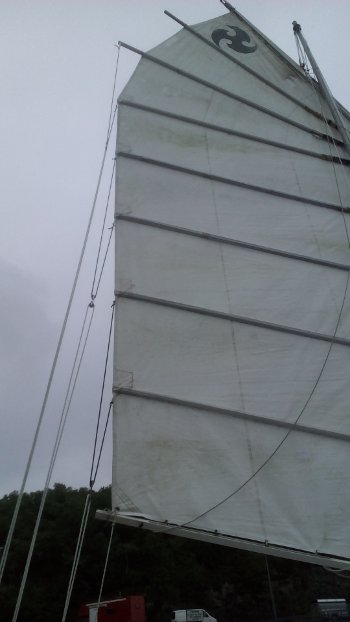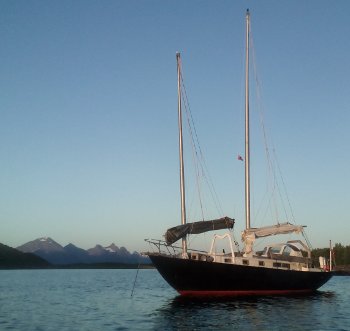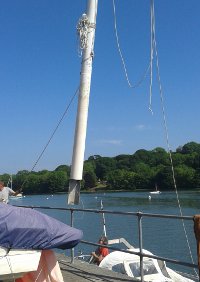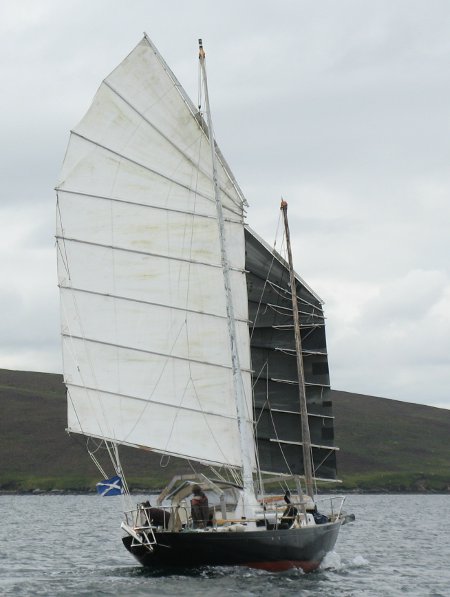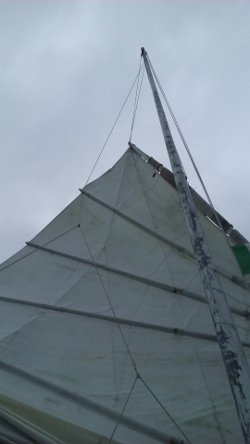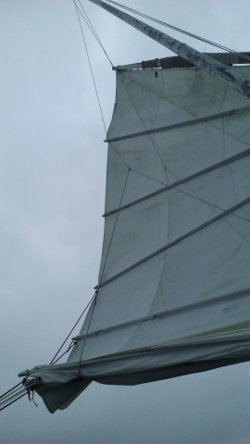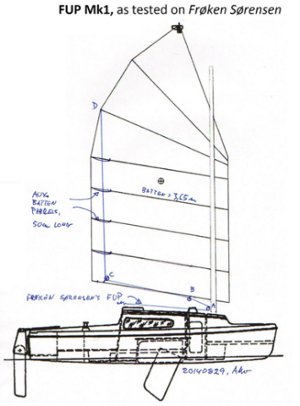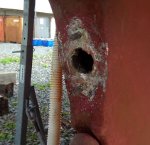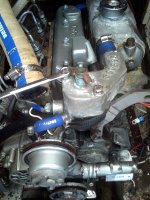Back on track
I have finally ‘cracked the code’ and can log back into this wordpress blog after being shut out for the past year. Persistence pays off!
Quick recap: In Spring 2018 I sailed singlehanded from Port Bannatyne, Bute down to Dale, Pembrokeshire Wales stopping for a couple of weeks in Port Saint Mary’s, Isle of Man on the way. After leaving it at Dale bay at anchor all summer I sailed back up to Scotland stopping at Tayvallich for a few days rest before sailing up to Loch Aline for a short rest then off to the Minch. then up and over to Lochinver arriving at August 22 – where I remain to this day, 5 June 2019.
I came back here in mid-April to prepare the boat for a fun trip up to the Faroes with Alison. I have made some modifications to the rig while waiting for fair winds. Still waiting, and waiting, and waiting, as cold northerly winds descend on us with little respite. We must be in a global cooling emergency!
Junk rig modifications
Foresail topping lift layout
I have forgotten how many times my foresail boom has been snapped in two after a brisk sail somewhere or the other. In response I simply furl it one panel and carry on without issue. I usually keep it functioning for the next sail with a temporary splint. Later I replace it with a new boom. And then the cycle repeats.
In my first sail across the Atlantic in my then new Junk rig (2012) I snapped the foresail boom first, and then later the lowest batten, meaning the two lowest panels were lost for action.
But why does the boom keep breaking, you ask?
Because the forward end of it gets caught in the bow pulpit and one fast gibe means something has to break at the point of greatest resistance – in this case the boom where it touches the mast.
But why does the forward end of the boom get caught in the pulpit you ask?
Because in brisk and lumpy sailing conditions it can sink down as the aft end of the sail rises up. This happens because I have approximately 25% – 30% balance on the foresail. In other words, 25% to 30% of the foresail rests forward of the mast, yet the topping lifts only support the sail that is aft of the mast. 95% of the time this is not a problem. But occasionally the forward end of the boom sinks too low below the pulpit rail, the gibe occurs and snap!
The potential solution I have is to extend the topping lift supports forward to support that part of the sail that extends forward of the mast. What could possibly go wrong? Nothing that I can see so far having taken it for a short sail out and about.
Extra sheeted mainsail batten
As part of my ‘anti-fanup‘ strategy. I have extended both top battens in the fan and will extend the boom further too (although for now I will stick with my temporary extension I rigged up in Norway in 2017).
With the extended battens I now had the opportunity to sheet the lower fan batten as its extension brought it in vertical line the the lower leech. (Without the extension, sheeting this batten would have resulted in the sheet and sheet batten spans snagging on lower leech when tacking or gibing.)
Of course I still wanted to maintain the anti-twist characteristic of the sheeting arrangement by keeping the power to each batten the same pull strength. I though up all sorts of complicated systems to accomplish this and then decided the simple and somewhat obvious way was the best – move all sheet spans up one batten and then sheet the now sheetless boom with the use of an additional block and the standing end.
A short sail around the harbour proved that this worked. No twist in the leech as each batten and boom is served with the same power – power of 1 sheet line for the boom and 2 sheet lines (divided by 2 with the spans) for each batten.
With this arrangement the twist in the previously unbattened fan, although minor, is now less. This also decreases the stress on the topping lifts when deeply furled to fan only – an all round improvement in my books.
5 part main halyard
As I may have ranted in previous posts, extreme twisting of the main halyard has cause me great consternation in the past. I have now switched from a 4 part halyard to a 5 part halyard with a triple block at the masthead and the standing end attached to the boom. On the four part halyard the standing end was at the mast head – requiring me to climb the mast (something I prefer to avoid if possible) when I need to replace of smooth out the entire length of halyard.
Now I can replace the halyard with a new or temporary line while remaining on deck.
Two other changes to the main halyard to note:
- I am allowing the double block on the yard to swivel if it wants. This way it will find its own preferred angle when sailing cutting down on the wear and strain on the block when sailing.
- I am placing a swivel shackle on the standing end where it attaches to the yard. This will allow the line to untwist itself while the sail is hoisted and lowered. If that isn’t sufficient I can untwist it myself by hand from the deck without needing to remove the line from the blocks
Both of these changes are experimental – their worth unproven by extensive use and testing.
With regards to the mast head block arrangement, I have replaced the double block (aft port crane) and single bloc (aft starboard crane handling the running end) with a triple block on the aft port crane. The running end comes out of the centre sheave as displayed in the Practical Junk Rig book. It seems a bit odd and has the 2 sheaves on the yard moving in opposite circles. It should work – to be validated with use.
Now that I have recovered the password for this blog, I will update the success (or failure) of my modifications after I get back from the Faroes this summer – if the weather ever improves!




